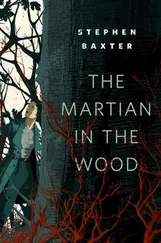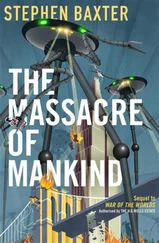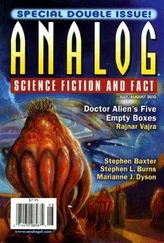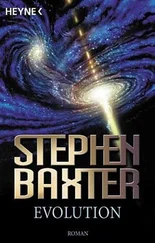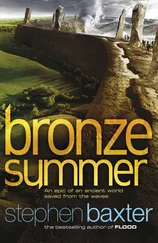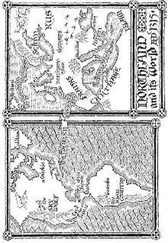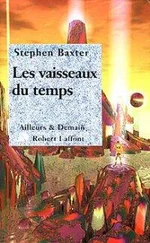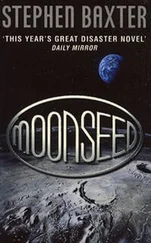There was a snarl, of greed and anger. It came from just above her head. She quailed, slipped. She finished up dangling by her one hand.
She looked up.
It was human. Or, it might once have been human. It must have been four, five times her size. It was naked, and it clung to the tree above her, upside down, so that a broad face leered, predator’s eyes fixed on her. Its limbs were cylinders of muscle, its chest and bulging belly massive, weighty. And it was male: an erection poked crudely between its legs. She hadn’t been able to see it for the mist, until she had almost climbed into it.
It thrust its mouth at her, hissing. She could smell blood on its breath.
She screamed and lost her grip.
She fell, sliding down the trunk. She scrabbled for purchase with her feet and her one good hand. She slammed repeatedly against the trunk, and when she hit the ground the wind was knocked out of her.
Above her, the beast receded, still staring into her eyes.
Ignoring the aches of battered body and torn feet, she blundered away, running until she reached the openness of the beach. For an unmeasured time she lay there, drawing comfort from the graininess of the dust.
The craft was called a GUTship.
As finally assembled, it looked something like a parasol of iron and ice. The canopy of the parasol was the surface ferry, now serving as a habitable lifedome, and the ‘handle’ was the GUTdrive unit itself, embedded in a block of asteroid ice which served as reaction mass. The shaft of the parasol, separating the lifedome from the drive unit, was a kilometre-long spine of metal bristling with antennae and sensors.
In a hundred subtle ways the ship showed its age. Every surface in the lifedome was scuffed and polished from use, the soft coverings of chairs and bunks were extensively patched, and many of the major systems bore the scars of rebuilding. The design was centuries old. The ship itself had been built long before the Occupation, and lovingly maintained by a colony of refugees who had seen out the Qax era huddled in the asteroid belt.
GUT , it seemed, was an acronym for Grand Unified Theory. Once, Gemo whispered, unified-theory energy had fuelled the expansion of the universe. In the heart of each GUT engine asteroid ice was compressed to conditions resembling the initial singularity – the Big Bang. There, the fundamental forces governing the structure of matter merged into a single unified superforce. When the matter was allowed to expand again, the phase energy of the decomposing superforce, released like heat from condensing steam, was used to expel asteroid matter as a vapour rocket.
Remarkable, exotic, strange. This might be a primitive ship compared to a mighty Spline vessel, but Hama had never dreamed that mere humans had once mastered such technologies.
But when they were underway, with the lifedome opaqued over and all the strangeness shut out, none of that mattered. To Hama it was like being back in the Conurbations, in the enclosed, claustrophobic days before the Occupation was lifted. A deep part of his mind seemed to believe that what lay beyond these walls – occupied Earth, or endless universe – did not matter, so long as he was safe and warm. He felt comfortable in his mobile prison, and was guilty to feel that way.
All that changed when they reached Callisto.
The sun was shrunk to the tiniest of discs by Jupiter’s remoteness, five times as far as Earth from the central light. When Hama held up his hand it cast sharp, straight shadows, the shadows of infinity, and he felt no warmth.
And through this rectilinear, reduced light, Callisto swam.
They entered a wide, slow orbit around the ice moon. The satellite was like a dark, misty twin of Earth’s Moon. Its surface was crowded with craters – even more so than the Moon’s, for there were none of the giant lava-flood seas that smoothed over much lunar terrain. The largest craters were complex structures, plains of pale ice surrounded by multiple arcs of folded and cracked land, like ripples frozen into shattered ice and rock. Some of these features were the size of continents, large enough to stretch around this lonely moon’s curved horizon, evidently the results of immense, terrifying impacts.
But these great geological sculptures were oddly smoothed out, the cracks and ripples reduced to shallow ridges. Unlike Earth’s rocky Moon, Callisto was made of rock and water ice. Over billions of years the ice had suffered viscous relaxation; it flowed and slumped. The most ancient craters had simply subsided, like geological sighs, leaving these spectacular palimpsests.
‘The largest impact structure is called Valhalla,’ Gemo was saying. ‘Once there were human settlements all along the northern faces of the circular ridges. All dark now, of course – save where Reth has made his base.’
Nomi grunted, uninterested in tourism. ‘Then that’s where we land.’
Hama gazed out. ‘Remarkable,’ he said. ‘I never imagined—’
Gemo said caustically, ‘You are a drone of the Occupation. You never imagined a universe beyond the walls of your Conurbation, you never even saw the sunlight, you have never lived. You have no memory . And yet you presume to judge. Do you even know why Callisto is so-called? It is an ancient myth. Callisto was a nymph, beloved of Zeus and hated by jealous Hera, who metamorphosed her into a bear…’ She seemed to sense Hama’s bafflement. ‘Ah, but you don’t even remember the Gree-chs, do you?’
Nomi confronted her. ‘ You administered the Extirpation, pharaoh. Your arrogance over the memories you took from us is—’
‘Ill-mannered,’ Hama said smoothly, and he touched Nomi’s shoulder, seeking to calm the situation. ‘A lack of grace that invalidates her assumption of superiority over us. Don’t concern yourself, Nomi. She condemns herself and her kind every time she speaks.’
Gemo glared at him, full of contempt.
But now Jupiter rose.
The four of them crowded to see. They bobbed in the air like balloons, thrust into weightlessness now the drive was shut down.
The largest of planets was a dish of muddy light, of cloudy bands, pink and purple and brown. Where the bands met, Hama could see fine lines of turbulence, swoops and swirls like a lunatic water-colour. But a single vast storm disfigured those smooth bands, twisting and stirring them right across the southern hemisphere of the planet, as if the whole of Jupiter were being sucked into some central maw.
As perhaps it was. There was a legend that, a century before, human rebels called the Friends of Wigner had climaxed their revolt by escaping back through time , across thousands of years, and had hurled a black hole into the heart of Jupiter. The knot of compressed spacetime was already distorting Jupiter’s immense, dreamy structure, and perhaps in time would destroy the great world altogether. It was a fantastic story, probably no more than a tale spun for comfort during the darkest hours of Occupation. Still, it was clear that something was wrong with Jupiter. Nobody knew the truth – except perhaps the pharaohs, and they would say nothing.
Hama saw how Sarfi, entranced, tried to rest her hand against the lifedome’s smooth transparency. But her hand sank into the surface, crumbling, and she snatched it away quickly. Such incidents seemed to cause Sarfi deep distress – as if she had been programmed with deep taboos about violating the physical laws governing ‘real’ humans. Perhaps it even hurt her when such breaches occurred.
Gemo Cana did not appear to notice her daughter’s pain.
The lifedome neatly detached itself from the ship’s drive section and swept smoothly down from orbit. Hama watched the moon’s folded-over, crater-starred landscape flatten out, the great circular ramparts of Valhalla marching over the close horizon.
Читать дальше

